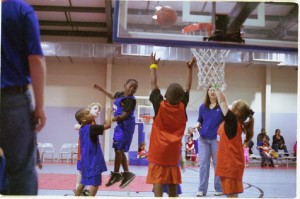Game Sense Approach to Basketball Coaching
The Game Sense approach is a process focusing on the instruction of young players in learning about sport. Game Sense as it reads is about games or group based activities. The predominant method of instructing players in the techniques and tactics about a sport is through the use of multiple player games. This strategy is seen as more favourable then the breakdown and building up of a player’s competence through technical skill practice and repetition associated more commonly with older or senior players.

There are a number of benefits associated with the Game Sense approach for instructing young children. Some of these benefits include:
- Promotion of game activities very early on in skill development
- Players perceive the tasks associated with the sport as easier
- Mass participating of team members in each and every activity or drill
- Young athletes view this approach as more fun, exciting and engaging
These positives can help promote a sport with younger players and help to keep individuals interested in the sport for longer. This is always of core concern with children’s first introduction to sport. If they do not enjoy the activity from the very start, they are less likely to continue to be involved. In some instances the drop off can be very significant and be the subject of much concern for program administrators. To help with this issue Game Sense looks to increase the positive experiences through participation of young players in training session’s drills.
The Game Sense approach starts with the tactical elements being introduced to players, rather than the individual technical skills for a situation. For instance, a coach might look to develop a drill that focuses around the fundamental skills, but instead of having 1 v 0 or 1 v 1 aspects covered initially. The coach would start with a two player breakdown drill. The most favourable drills selected will be 3 v 3 and 4 v 4 within the Game Sense approach. This is because more players can become involved and constantly active. The skill here for the coach is in selecting drills appropriate for teaching the fundamental technical skills and focusing on these while based in a tactical drill.
A common problem for coaches when they first use the Game Sense approach is they misconstrue the reference to tactical drills as also only being in competitive situations. This is not the case however, and it is often very beneficial for a coach to introduce the activity in a “no defence” breakdown before then rapidly moving onto competitive games. For example a coach when teaching technical skills such as Pass, Cut and Replace facilitate these through 3 v 0 and 4 v 0 situations then after the groups has had a minimum of three repetitions move into the competitive situations of 3 v 3 and 4 v 4.
Alternatively, there is no reason a coach does not use a “numbers advantage” in drills to help with the ease that players can perform the new tactical skills and experience success. For example, change the motion principles offense drill discussed earlier from 3 v 3 to 3 v 2. This will result in the offense players finding the ability to shoot and score easier helping with motivation and positive reinforcement of the children.
The Game Sense approach is not about just playing games, but also managing a players development just the same as through traditional methods by selecting drills which still focus on technical skills in a tactical context.







